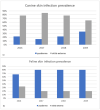On Gram-Positive- and Gram-Negative-Bacteria-Associated Canine and Feline Skin Infections: A 4-Year Retrospective Study of the University Veterinary Microbiology Diagnostic Laboratory of Naples, Italy
- PMID: 34072316
- PMCID: PMC8227065
- DOI: 10.3390/ani11061603
On Gram-Positive- and Gram-Negative-Bacteria-Associated Canine and Feline Skin Infections: A 4-Year Retrospective Study of the University Veterinary Microbiology Diagnostic Laboratory of Naples, Italy
Abstract
A 4-year retrospective study (2016-2019) of selected routine bacteriological examinations of the veterinary microbiology laboratory of the University Veterinary Teaching Hospital of Naples (Italy) was carried out. A total of 189 bacteriological samples were collected from 171 dogs and 18 cats suffering from skin infections. In dogs, the most common cutaneous infection was otitis externa, while pyoderma was found to be prevalent in cats. The number of recorded Gram-positive strains over the study period did not vary considerably from year to year and was always significantly higher (p-value = 0.0007) in comparison with Gram-negative bacterial isolations. In dogs, Staphylococcus pseudintermedius was the most common identified Gram-positive bacterium (65%), while Pseudomonas aeruginosa (36%) was the one among the isolated Gram-negative bacteria. In cats, coagulase-negative staphylococci were the most predominant isolated bacteria (47%). The phenotypic profiles of antibiotic resistance showed that most of the strains were resistant to amoxicillin-clavulanate, penicillin, clindamycin, and trimethoprim-sulfamethoxazole. Several multi-drug-resistant strains (35%) were detected in canine isolates. An updating of antibiotic resistance profiles of the main Gram-positive and Gram-negative bacteria principally associated with skin infections of pet animals is necessary to improve stewardship programs of veterinary hospitals and clinics.
Keywords: Gram-positive and Gram-negative bacteria; antibiotic resistance; pet animals; skin infections.
Conflict of interest statement
The authors declare no conflict of interest.
Figures










Similar articles
-
The impact of stray animal populations on public health in Naples, Italy: A preliminary study on antimicrobial resistance on the road.Comp Immunol Microbiol Infect Dis. 2025 Jun;120:102344. doi: 10.1016/j.cimid.2025.102344. Epub 2025 Apr 26. Comp Immunol Microbiol Infect Dis. 2025. PMID: 40311406
-
Prevalence of the microbiological causes of canine otitis externa and the antibiotic susceptibility of the isolated bacterial strains.Pol J Vet Sci. 2023 Sep 20;26(3):449-459. doi: 10.24425/pjvs.2023.145052. Pol J Vet Sci. 2023. PMID: 37727503
-
First identification of methicillin-resistant Staphylococcus pseudintermedius strains among coagulase-positive staphylococci isolated from dogs with otitis externa in Trinidad, West Indies.Infect Ecol Epidemiol. 2015 Dec 28;5:29170. doi: 10.3402/iee.v5.29170. eCollection 2015. Infect Ecol Epidemiol. 2015. PMID: 26715379 Free PMC article.
-
[Etiology of bacterial infections in febrile neutropenic patients: the role of the laboratory in the diagnosis].Presse Med. 2004 Apr 10;33(7):460-6. doi: 10.1016/s0755-4982(04)98633-2. Presse Med. 2004. PMID: 15105768 Review. French.
-
Prevalence of Bacterial Pathogens Isolated from Canines with Pyoderma and Otitis Externa in Korea: A Systematic Review and Meta-Analysis.Vet Sci. 2024 Dec 16;11(12):656. doi: 10.3390/vetsci11120656. Vet Sci. 2024. PMID: 39728996 Free PMC article. Review.
Cited by
-
Antimicrobial Resistant Staphylococcus Species Colonization in Dogs, Their Owners, and Veterinary Staff of the Veterinary Teaching Hospital of Naples, Italy.Pathogens. 2023 Aug 5;12(8):1016. doi: 10.3390/pathogens12081016. Pathogens. 2023. PMID: 37623976 Free PMC article.
-
Antimicrobial Resistance and Risk Factors of Canine Bacterial Skin Infections.Pathogens. 2025 Mar 24;14(4):309. doi: 10.3390/pathogens14040309. Pathogens. 2025. PMID: 40333053 Free PMC article.
-
A Cross-Sectional Study of Veterinarians in Germany on the Impact of the TÄHAV Amendment 2018 on Antimicrobial Use and Development of Antimicrobial Resistance in Dogs and Cats.Antibiotics (Basel). 2022 Apr 5;11(4):484. doi: 10.3390/antibiotics11040484. Antibiotics (Basel). 2022. PMID: 35453235 Free PMC article.
-
Chromogenic culture media complements diagnostic cytology in the visual identification of pathogenic skin bacteria in dogs and cats.Front Vet Sci. 2023 Jul 11;10:1152229. doi: 10.3389/fvets.2023.1152229. eCollection 2023. Front Vet Sci. 2023. PMID: 37496749 Free PMC article.
-
Genetic diversity and antimicrobial resistance profiles of Staphylococcus pseudintermedius associated with skin and soft-tissue infections in companion animals in Lisbon, Portugal.Front Microbiol. 2023 Apr 17;14:1167834. doi: 10.3389/fmicb.2023.1167834. eCollection 2023. Front Microbiol. 2023. PMID: 37138637 Free PMC article.
References
-
- De Martino L., Nocera F.P., Mallardo K., Nizza S., Masturzo E., Fiorito F., Iovane G., Catalanotti P. An update on microbiological causes of canine otitis externa in Campania Region, Italy. Asian Pac. J. Trop. Biomed. 2016;6:384–389. doi: 10.1016/j.apjtb.2015.11.012. - DOI
Grants and funding
LinkOut - more resources
Full Text Sources
Molecular Biology Databases
Miscellaneous

